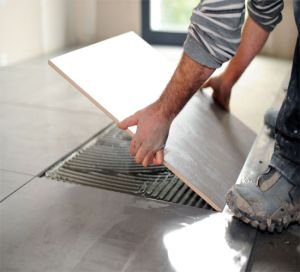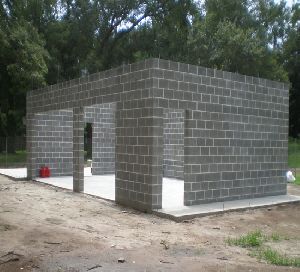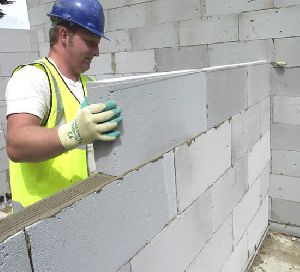
Waterproof Coating
Minar Water Seal is impermeable waterproof coating with very high adhesion capacity, useful for protecting surfaces from positive as well as negative pressure of water. Application For Roof Slab / Sanitary Blocks / Basement / Sunk Slab Etc 1. Clean entire slab with wire brush ensuring all loose particles like dust, oil, grease and fungus is removed thoroughly. 2. Wash entire surface with potable water. Ensure that there is no waterlogged area. 3. Widen all creaks mechanically or manually. Fill all creaks with paste using Minar Water Seal and Water (20 to 25% of powder). 4. Thoroughly mix powder with 35 – 40 % water. There should not be any bubble in liquid. Mechanical stirrer is advisable to mix it evenly as well as save labour. 5. Before applying on slab pre-wetting of surface is required. 6. Apply one coat horizontally and second coat (after drying of first coat) vertically to ensure no area is left behind. Well designed application of Minar Water Seal stops water seepages of below ground structures like Basement and Underground Tanks. It protects costliest paint from rising damp of walls. This product is applicable at terrace leakage, Dampness on wall surface, high rise building basement (to stop the outside water)
Packaging Type : 1, 5, 20 and 40 kg
...more
Wall Putty
500 Per Bag
Packaging Type : Bag
Packaging Size : 40 kg
Putty Form : Powder
...more
tile fix
High Performance Tile Adhesive for Ceramic and Vitrified Tiles, Granite and Marble Advantages: Self curing adhesive Flexible, shock and Impact resistant Easy to use Fast and economical High bond strength SURFACE PREPARATION Clean the substrate of oil stains and also remove dirt, dust and laitance, if any, using high pressure water jet or any other suitable method. Ensure that the substrate is flat, stable, well adhered and has a normal absorption. Concrete screeds, plastered surfaces, block work and renders should be sufficiently cured to avoid shrinkage cracks. Correct the local undulations/damages on the substrate at least 48 hours before the application of MINAR TILE FIX Saturate the surface well and remove excess water before application of the tile adhesive. MIXING RATIO Gradually add 3 parts of powder to 1 part of water (by volume) and After mixing allow the paste to stand for 2 minutes for it to mature. TILE FIXING Apply MINAR TILE FIX over the surface using the straight edge of the notched trowel and then comb the applied adhesive on the notched side of the trowel to achieve the desired thickness. If the adhesive is buttered to the tile, then ensure proper coverage of tile surface to avoid voids. Firmly press the tile into the adhesive to ensure good initial bonding. CONSUMPTION For 3mm bed thickness the coverage will be 4-4.5 kg/sqm Note: The coverage will vary depending on surface undulations SHELF LIFE 1 year from the date of manufacturing, for unopened bags, stored in a dry condition. Tile Grout TECHNICAL DATA PREPARATION: The Joint filling can be done after 24 hrs of tiling. The joints should be clean. Tile Fixing adhesive should not rise over half the depth of the joints. Excess mortar should be removed. MATERIAL MIXING: Quantities up to 500mg may be mixed by hand. Mix Minar Tile Grout with 175 to 200 ml of clean water to a smooth consistency. For larger quantities, use a mechanical mixer until mixture is homogeneous - firm smooth paste. Use immediately APPLICATION: A rubber trowel may be used for applying the grout. The grout is applied diagonally over the tiles and pressed firmly into the joints until they are completely filled. Excess grout on tiles should be removed. The grout should be allowed to dry for 15 to 30 minutes depending on temperature and humidity. A damp sponge is then used to clean the tile surface. Use as little water as possible for cleaning the joints and the tiles. To make cleaning easier, unglazed tiles should be moistened with a damp sponge before grouting. Tile surface is left to dry before final wiping with dry cloth. While wiping and polishing, do not rub the joints too hard. In dry conditions, curing may be necessary. STORAGE Store in a sheltered and dry place
...more
Paver Blocks
MPPL is one of the largest manufacturers of interlocking paving blocks. The company manufactures different grade of paver blocks ranging from M20 to M50. Roads constructed using interlocking paving blocks provides better aesthetic look then conventional cast in place concrete road. 60MM THICKNESS M20 GRADE 1.88 NO / SQFT CONSUMPTION TRUCK LOAD – 1450 NOs 190 mm (L) * 390 mm (H) * 90 mm (T)
...more
Hollow Blocks
Fly-ash / Hollow Blocks: MPPL is the single largest manufacturer of Baroda supplying hollow concrete blocks in all parts of Gujarat. Wide range of concrete blocks with large inventory provides flexibility and speed in construction to construction companies. Compressive Strength 30 to 35 kg Cm2 INTRODUCTION: Hollow concrete blocks are substitutes for conventional bricks and stones in building construction. They are lighter than bricks, easier to place and also confer economics in foundation cost and consumption of cement. In comparison to conventional bricks, they offer the advantages of uniform quality, faster speed of construction, lower labour involvement and longer durability. In view of these advantages, hollow concrete blocks are being increasingly used in construction activities. STRUCTURAL ADVANTAGES In this construction system, structurally, each wall and slab behaves as a shear wall and a diaphragm respectively, reducing the vulnerability of disastrous damage to the Structure / building during the natural hazards. Due to the uniform distribution of reinforcement in both vertical and horizontal directions, through each masonry element, increased tensile resistance and ductile behaviour of elements could be achieved. Hence, this construction system can safely resist lateral or cyclic loading, when compared to other conventional masonry construction systems. This construction system has also been proved to offer better resistance under dynamic loading, when compared to other conventional systems of construction. CONSTRUCTIONAL ADVANTAGES No additional formwork or any special construction machinery is required for reinforcing the hollow block masonry. Only semi-skilled labour is required for this type of construction. It is a faster and easier construction system, when compared to the other conventional construction systems. It is also found to be a cost-effective disaster resistant construction system, as explained in the next section. ARCHITECTURAL AND OTHER ADVANTAGES This construction system provides better acoustic and thermal insulation for the building. This system is durable and maintenance free. Reduction in Dead Load Reduced Air Conducting Load: - Approx.50% saving. No salt peter or leaching: - Reduction in maintenance. Increased carpet area: - Due to smaller in size. Faster construction: - Easy to work with bigger in size. Assured Quality: - Fully automatic block plant. Better sound absorption: - Being hollow in nature. Reduced thickness of plaster: - Due to size accuracy & less cement consumption due to fewer joints. Load bearing walls: - Due to higher strength of blocks. Recommended for earth quake resistance. Less water absorption:- Approx. 3 to 4% Environmental Eco-Friendly Reduce in total cost of project: - Being less dead load of walls. THE STANDARD SIZES OF HOLLOW CONCRETE BLOCKS ARE – Hollow blocks with two cavity in each block (a) 400mm x 200mm x 200mm (b) 400mm x 200mm x 150mm (c) 400mm x 200mm x 100mm Half Blocks (d) 200mm x 200mm x 200mm (e) 200mm x 200mm x 150mm (f) 200mm x 200mm x 100mm
...more
Epoxy tile-grout
Advantages 1. High Adhesion :Long lasting adhesion with substrates.2. Waterproofing:It provides good resistance to water penetration from joints in wet areas3. Hygienic: Ideal for areas where hygiene maintenance is critical like Laboratories, Breweries, Clinics and Bathrooms Technical details a. Pot life: Approx. 30 minutes b. Foot Traffic: 24 hrs c. Heavy Traffic: 7 days d. Specific gravity: 1.8 e. Sag: No sag f. Tensile Bond Strength (14 days air drying): > 4.5 Mpa g. Water absorption: Nil h. Shrinkage: Nil APPLICATION PROCEDURE Surface preparation : Before starting to grout, remove debris in grout joints and dust can be removed by compressed air jetting. Mixing: Mix Part A B and C as per ration given in pack thoroughly Application: Press the grout firmly by using a hard rubber squeeze, into joints ensuring that the joints are completely filled. Cleaning: Clean the surface with damp sponge in circular motion Precaution: Use gloves to ensure no contact with skin. Surface must be dry. It is recommended to use tapes for easy cleaning. COVERAGE Depends on the tile size and width of joint between tiles. Calculation Formula (Tile Length + Tile Breadth) x Tile Thickness x Joint Width x Specific Gravity / (Tile Length + Joint Width) x (Tile Breadth + Joint Width) = kg / sq.m SP GRAVITY OF CEMENTITIOUS TILE GROUT IS 1.8
...more
AAC Block Joining Mortar
Thin Layer Polymer Modified Concrete / AAC Block Joining Mortar Advantages Thin jointing material with very high adhesion strength Pre-mixed and ready-to-use. Only water is to be mixed at site Economical. Eliminates lengthy and cumbersome processes of site mixing, thus transport and storage of all individual materials is avoided Ease of mix and much faster application Thin layer application results in structure being compact No water curing is required after application Minimizes the undulation of the surface Being a thin layer, chances of water percolation is negligible Being premixed, it saves considerable time and labour Areas of Application Laying and jointing of fly ash bricks, cement blocks, hollow blocks, AAC blocks etc. Jointing of pre-stressed concrete slabs, panels. Parapet walls Jointing of cement window and door frames. Garden and boundary walls. Other Products White cement based Wall Putty Flexible Sealing Slurry for Waterproofing Hollow Concrete Blocks RCC Hume Pipes Interlocking Paver Blocks
...moreBe first to Rate
Rate ThisOpening Hours